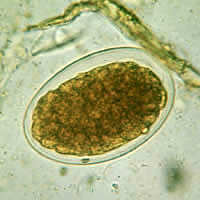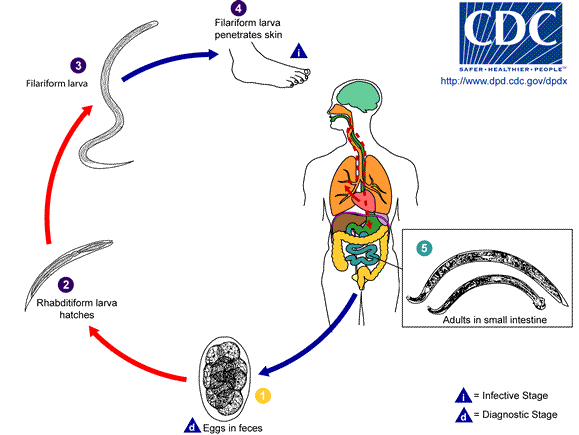Reproduction- the life cycle
The hookworm life cycle
has many stages and is dependent on a human host. Most of the
life of the hookworm is spent attached to the intestinal wall of
the host. However, at one point the male worm leaves and goes in
search of a mate. The females produces hormones that lead the
males to find them. Once a male has found its mate,
coils around her and covers her genital pore. Then the males
gubernaculum guides spicules which extend into the females cloaca and
anus. This allows the male to keep attached to the female during
mating. The male then releases the sperm onto the genital pore
of the  female. During her life span of about one year, a female hookworm
will lay about 10,000-30,000 eggs a day during her adult life.
Once these eggs are released, they travel with the stool and
hatch after a couple days of incubation (under ideal conditions,
warm and moist) , the eggs hatch and the
larval hookworms continue
their development in the soil. Once fully developed, larval
hookworms penetrate the skin of the human host and travel
through either the blood stream of the lymphatic system to the
lungs. Here the hookworm works its way up the respiratory tract
where it eventually gets swallowed by the human host and gets
into the intestinal tract. Once in the intestine, the larva will
develop into an adult and attach themselves to the lining, where
it all begins again.
female. During her life span of about one year, a female hookworm
will lay about 10,000-30,000 eggs a day during her adult life.
Once these eggs are released, they travel with the stool and
hatch after a couple days of incubation (under ideal conditions,
warm and moist) , the eggs hatch and the
larval hookworms continue
their development in the soil. Once fully developed, larval
hookworms penetrate the skin of the human host and travel
through either the blood stream of the lymphatic system to the
lungs. Here the hookworm works its way up the respiratory tract
where it eventually gets swallowed by the human host and gets
into the intestinal tract. Once in the intestine, the larva will
develop into an adult and attach themselves to the lining, where
it all begins again.